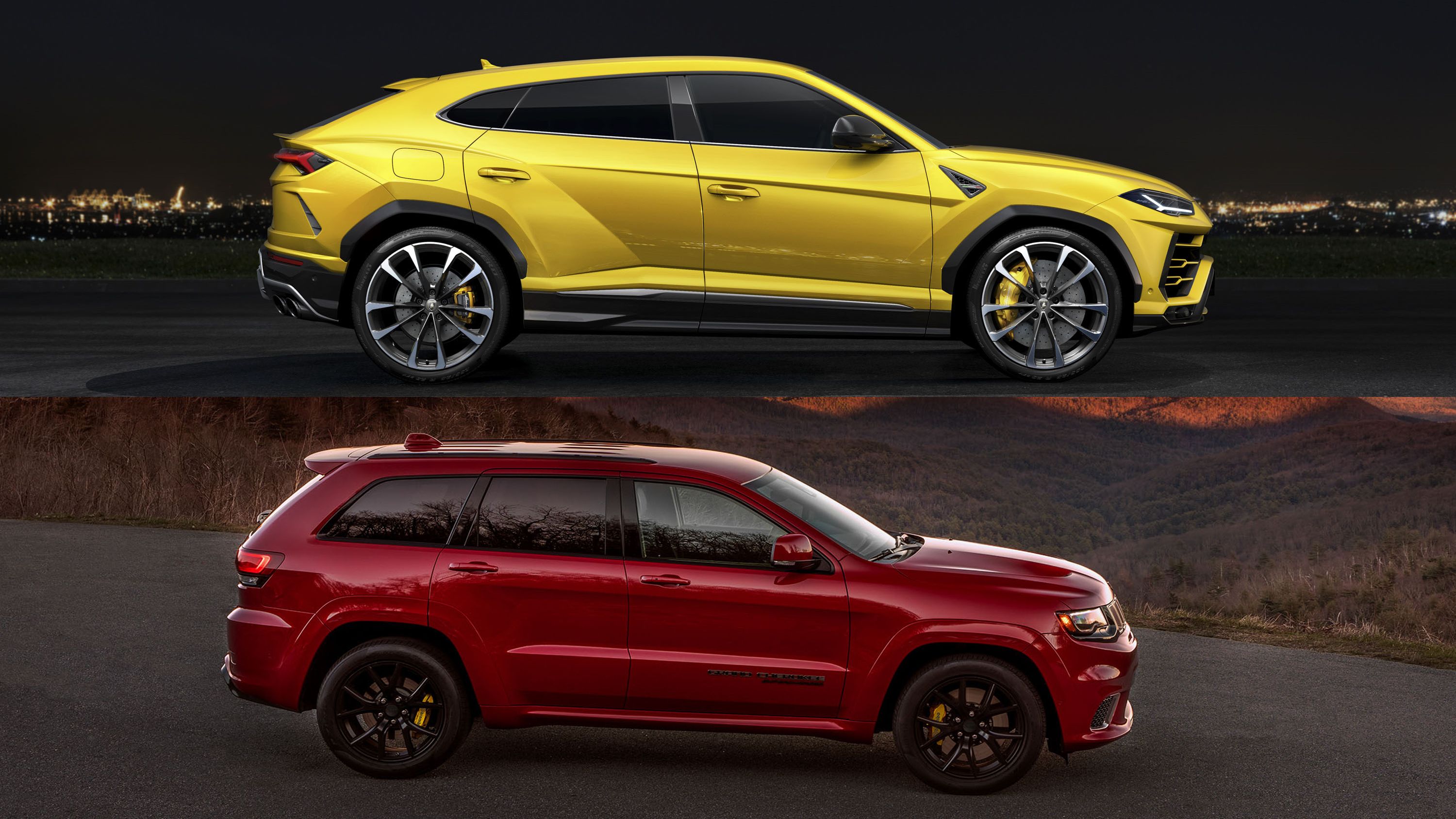The hype surrounding the Lamborghini Urus is real. It’s not just that the Urus is 650-horsepower horsepower; it’s because the Urus is a Lamborghini. The legendary Italian supercar brand has only released one SUV in its lifetime — the LM002 — and back then, SUVs weren’t as popular as they are now. That’s why the Urus is being talked about in glowing terms, even if it hasn’t been launched yet.
But is it really the most exciting SUV to hit the streets in recent memory? That’s a debatable question because there are others of its kind that are just as appealing, for one reason or another. The Bentley Bentayga is one of them. So is Alfa Romeo Stelvio Quadrifoglio. But for the purpose of this discussion, I’m turning my attention to an American SUV that can give the Urus a serious run for its money. It may not have the same prestige as the Urus, but the Jeep Grand Cherokee Trackhawk is every bit as potent as its Lamborghini counterpart.
Which of the two is better? That’s a question I’m looking to answer. Be advised, though. This isn’t a walk-over for the Lamborghini like some of you might think.
Continue after the jump to read the full story.
Exterior
This is the most subjective category in this comparison, and there’s good reason for that. The Lamborghini Urus carries a quintessential Lamborghini design that showcases plenty of aggression. There’s an edginess to the way it looks that’s typical of Lamborghini’s design philosophy. We talked to a number of people who aren’t into the industry, and more than one person described the Urus as a “raised” sports car. It’s not exactly the aptest description of the Urus, but you can understand it coming from people who aren’t as invested in the business as most of us are.
The Jeep Grand Cherokee Trackhawk is a lot like the Lamborghini Urus in the sense that it looks like a proper Jeep. There’s a brawniness to it that is a design hallmark of the American automaker. It’s aggressive in its own Jeep way. One look at the Grand Cherokee Trackhawk and you know it’s a Jeep. That counts for something, but it’s not enough for me to pick it over the Urus. As much as I like the Grand Cherokee Trackhawk, I’m picking the Urus here because it does look like a raised sports car.
Performance
If you look at it in terms of performance, the Jeep Grand Cherokee Trackhawk actually has the leg-up over the Lamborghini Urus. The Jeep’s secret weapon is its 6.2-liter supercharged Hemi V-8 engine that pumps out an incredible 707 horsepower and 645 pound-feet of torque. It’s a little more than the 650-horsepower output that comes out of the Urus’ 4.0-liter turbocharged V-8 engine. Both SUVs do have plenty of similarities, including all-wheel drive capability, large brakes, and the use of an eight-speed automatic transmission.
The two SUVs are also capable of sprinting from 0 to 60 mph in 3.5 seconds. That’s partly due to the Grand Cherokee Trackhawk weighing 600 pounds more than its counterpart. Move to the arena of top speed, and the Urus gets a slight edge in that department with its ability to peak at 186 mph. The Trackhawk, however, tops out at 180 mph.
Regardless of which of these two models you choose, it’s safe to say that you’re not going to be disappointed by their performance capabilities. I will give a slim edge to the Jeep Grand Cherokee Trackhawk for the simple reason that Jeeps aren’t supposed to this powerful. We expect it from Lamborghini, but it’s a welcome surprise for Jeep. That counts for something.
The “Wow” Factor
As impressive as the Jeep Grand Cherokee is, it’s not going to turn heads like the Lamborghini Urus. It could do that when it’s showcasing that Hemi V-8 engine, but the Urus is a magnet for attention regardless of whether it's running or not. That kind of cache is earned by reputation, and there’s really no comparison here.
Practicality
A big part of the Lamborghini Urus’ appeal lies in its novelty as a super-sized supercar. The good news is that it has cargo space in the back, a concept that’s pretty much foreign on any other Lambo model. But there’s really no comparison in terms of cargo space. There’s more of it inside the Grand Cherokee Trackhawk. The Jeep also has room for five adults, one more than the Lamborghini.
That said, the Urus does have an edge over the Grand Cherokee Trackhawk in terms of fuel economy. Lamborghini claims that its SUV can do 22 mpg, far better than the Trackhawk’s 17-mpg rating on highways and 13-mpg rating combined.
It’s a close call, but I’m giving the edge to the Jeep because it fits the profile of a people-mover more than the Lamborghini.
Pricing
The Jeep Cherokee Trackhawk takes this one by a landslide. Even if you fill it to the brim with features and other what-have-you’s, the Trackhawk’s price barely goes over $100,000. I know it’s a steep price to pay for a Jeep, but it’s a pittance compared to the $200,000 you’ll have to pay for a Lamborghini Urus. I get it that part of paying that $200k has to do with the Lambo’s pedigree as the creator of exclusive performance cars, but can you really justify paying that amount when you can get an equally capable SUV in the Trackhawk for half the amount?
This is the classic case of the phrase “your mileage may vary.” If you can pay for the Urus, make the purchase, but if you’re looking to spend without depleting your bank accounts, the Grand Cherokee Trackhawk is the better choice.
References
Lamborghini Urus
Read our full review on the 2019 Lamborghini Urus.
Jeep Grank Cherokee
Read our full review on the 2018 Jeep Grand Cherokee Trackhawk.

